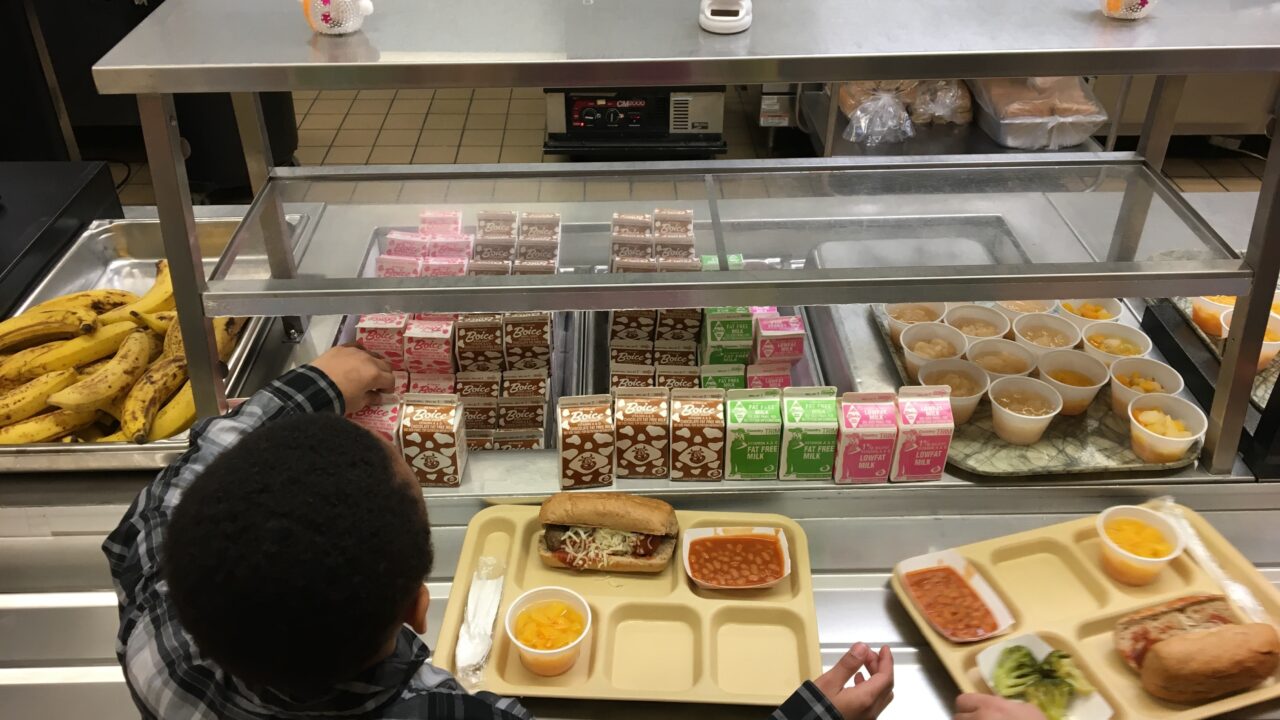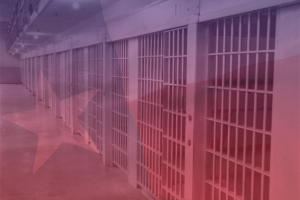Abolish School Lunch Debt
Punishing students for being unable to afford food hurts their education and development. Students fill their lunch trays at J.F.K Elementary School in Kingston, N.Y. Photo: Mary Esch / AP.
Students fill their lunch trays at J.F.K Elementary School in Kingston, N.Y. Photo: Mary Esch / AP.
The first years of the pandemic have been rough on school-aged children. Until recently, a federal program provided free school lunches for all students, offering a significant amount of stability to children and families. In June 2022, Congress ended the program, and students returned to paying for their lunch, placing a heavy burden on the 1.54 million students who cannot afford the cost.
The early pandemic-era child nutrition waivers from the federal government meant that every student—no matter their family income, state, or school district—had access to a free meal every day. This policy was desperately needed. Before the pandemic, school lunch programs nationwide were already in significant trouble. In a 2019 School Nutrition Association survey of school districts, three-quarters of all districts noted that families and students had some amount of school lunch debt. For some districts, the total amount of debt reached the hundreds of thousands.
The federal program essentially erased this problem overnight. Waivers for school meals were included in the first pandemic relief bill. However, with the recent end of the policy—a result of the administration taking a victory lap on supposedly defeating the pandemic despite about 3,000 people dying of COVID-19 every week—school lunch debt has now predictably reappeared. We have chosen to revert to a system that not only harms childhood nutrition, but places people in debt.
The last few years have allowed us to see how massively insufficient the government’s funding of school meals is. The School Nutrition Association’s survey from the first half of the 2023 school year found that the removal of the waiver caused 96% of school districts to report an increase in school lunch debt. The results can not be starker—children cannot afford school meals without a funding program. Why this program collapsed is typical for the American economy—where indifference (and antagonism) toward the poor and working class slowly chips away at effective programs or allows them to die in a sea of omitted sections of omnibus bills.
In the New Deal era, school lunches were introduced as a way for the farm industry to dispose of their surplus crops and create jobs.
It’s difficult to find someone who is outright opposed to student lunches. Anyone who has witnessed a hungry kid’s meltdown or tried to work on an empty stomach knows how important nutrition is for brain development, growth, and learning. School nutrition would seem to be a slam dunk, one of those no-brainer things that every politician should stand behind. However, this isn’t the first time we’ve struggled to give kids meals at school. School meals were not the norm before the economic relief brought on by former President Franklin Roosevelt’s New Deal. Previously, school meals existed as a result of philanthropy.
In the New Deal era, school lunches were introduced as a way for the farm industry to dispose of their surplus crops and create jobs. The program fluctuated based on which surpluses the farm industry had at any given time. The program wasn’t made permanent until the post-World War II Truman administration. The National School Lunch Act of 1946 standardized school lunches, put nutritional standards in place, and created the federal framework still in use today. The 1946 law framed feeding children as a matter of national security.
School breakfasts have an even more recent story. They were authorized as a national program in the 1960s, although the breakfast program may have never expanded without the federal government’s fear of and obsession with destroying the Black Panther Party. The party’s free breakfast program was widely considered a success for all participants, but the federal government worried it would be used as a tool for radicalization and largely considered it a dangerous nuisance. The state’s campaign to shut down the program was successful, but the Black Panther Party had already proved the efficacy of providing breakfast to children.
Over the years, school lunch programs have been eroded by lawmakers, resulting in a decline in the quality of school meals and an increase in the price of school lunches. Free and reduced lunch programs still exist, but they contain burdensome application processes for families. When families can’t afford the cost of a meal, which is typically $2.75 for an elementary school lunch and $3 for a middle or high school lunch, the student goes into debt, which can result in significant social embarrassment and financial stress.
Take the school district of Livonia, Michigan. Its regular full-price lunch is $3.50, and the school menu shows that a meal could be rotini with meat sauce, a roll, broccoli, and milk on some days. A student in school lunch debt receives an alternative lunch of graham crackers, string cheese, a fruit cup, and milk. The lower quality meal can embarrass the student and punish their nutrition. While substitute meals are embarrassing enough, school officials nationwide have left students hungry and shamed them for not having enough money. In Dowagiac, Michigan, school attendants tossed a student’s lunch in the trash for an outstanding balance of $4.95. In Rhode Island, a school district sent a debt collector after families. Some districts have gone as far as stamping the hands of children who fail to pay for their lunch, and in Luzerne County, Pennsylvania, one school district sent notes home threatening that students with school lunch debt would be placed in foster care.
Individualist and capitalist notions would have the phrase “school lunch debt” invoke blame onto seemingly irresponsible students and families.
It’s important to think about the lessons this system teaches children. Students mired in school lunch debt are surrounded by signs that tell them the debt is their fault. This is not accidental. The U.S. consistently frames poverty as a moral and personal failure to distract from the government’s own failures, including its continued investment in militarism and imperialism as children go hungry. Capitalism thrives on the idea that no matter what the circumstances, you are personally responsible for your position in the economy. At school, the manifestation of this idea is that if you go hungry, it is your family’s fault.
School lunch debt clearly indicates a political failure, not a personal one. Nothing has made this more clear than the contrast in policy over the past few years. Politicians and lobbyists enforce a system that fails to provide even basic support to citizens. Continuation of the program is estimated at about $11 billion and would have accounted for about 0.7% of the overall $1.5 trillion spending bill. Despite overwhelming evidence supporting the importance of school meals and the relatively small cost of continuing the program, the U.S. has chosen to let our children go without food. School meals have always been an afterthought in the American capitalist system. It is not due to cost, but rather a lack of political will and priority.
Individualist and capitalist notions would have the phrase “school lunch debt” invoke blame onto seemingly irresponsible students and families, but when you hear it, you should instead place the blame squarely on our political leaders. Policymakers have failed to prioritize the basic needs of children and have instead fed their desire to teach them how to be an indebted class. Feeding kids is a political slam dunk and a moral obligation. But the U.S. government has shown that its only priority is maintaining a classist system, which means depriving children of nutritious meals and placing them in debt.
Your support matters…Independent journalism is under threat and overshadowed by heavily funded mainstream media.
You can help level the playing field. Become a member.
Your tax-deductible contribution keeps us digging beneath the headlines to give you thought-provoking, investigative reporting and analysis that unearths what's really happening- without compromise.
Give today to support our courageous, independent journalists.






You need to be a supporter to comment.
There are currently no responses to this article.
Be the first to respond.